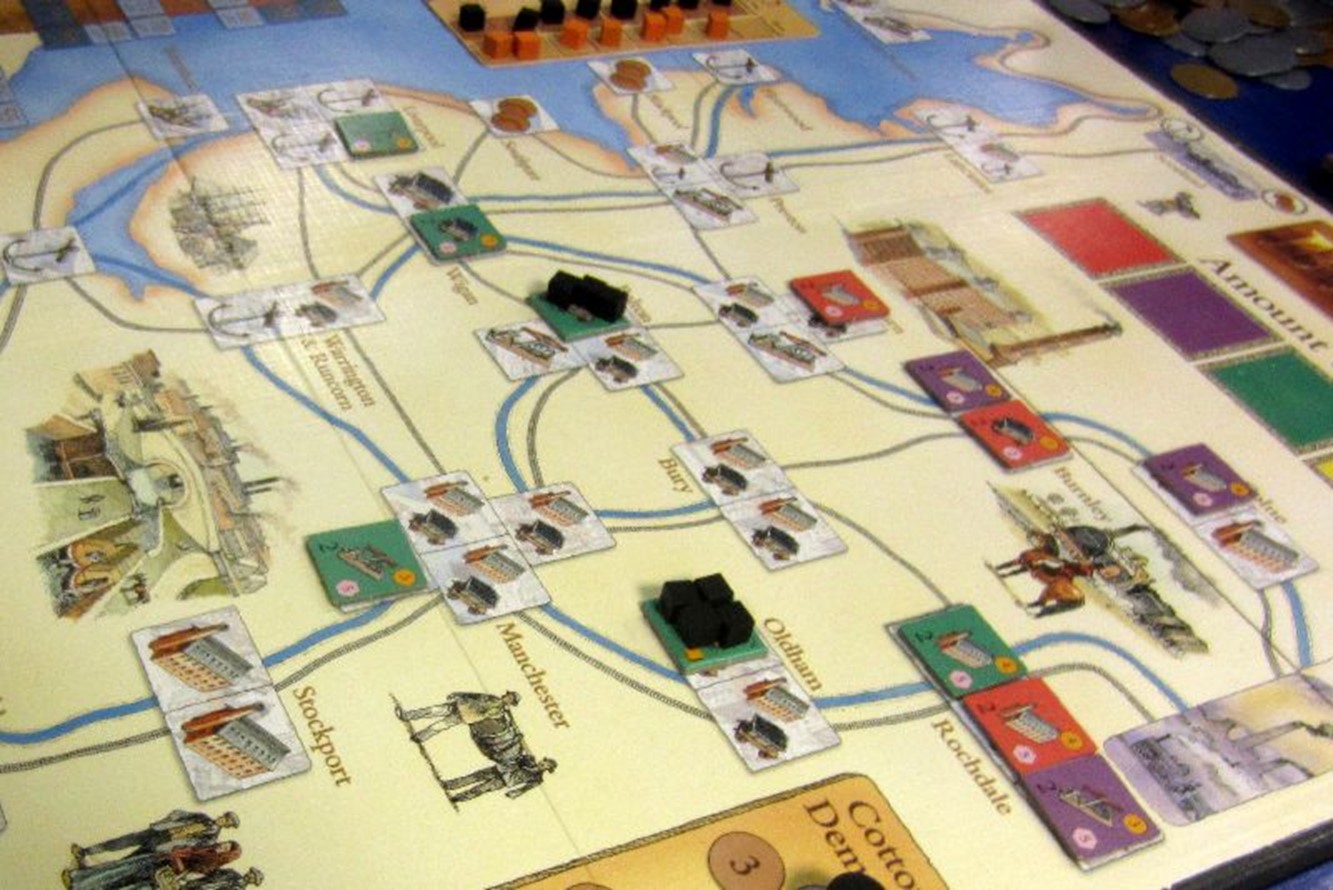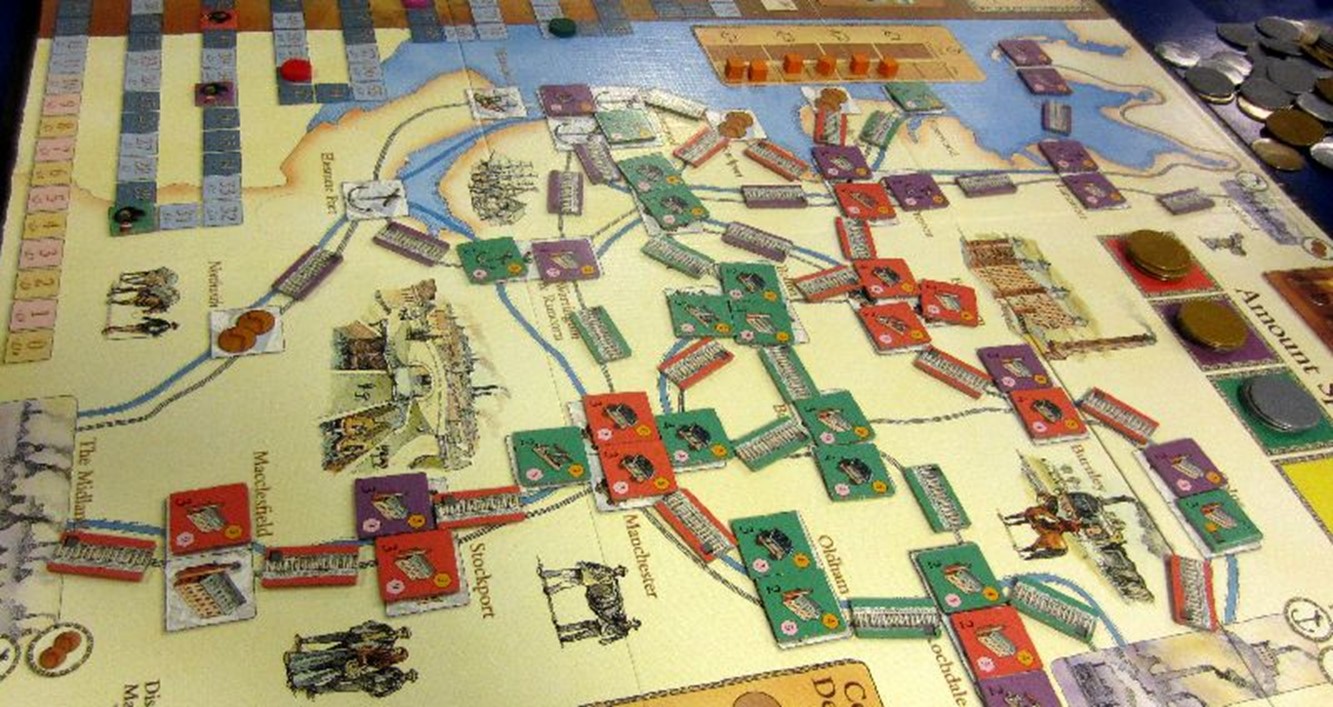There are a few board game designers that I pay a lot of attention to. Stefan Feld, Vlaada Chvatil and Martin Wallace are likely the three top designers on that list. Martin Wallace has a great range of designs, some of which I enjoy, others which I avoid, but there’s no doubt that his design of Brass, which looks at the Industrial Revolution in Great Britain, is one of his very best designs. I was able to play it on Thursday evening with Sarah and Jon, as Jon had a week’s rest from the Blood Bowl tournament that has been running all summer.
Colours for this game were mostly based on our individual preferences: I prefer Green, Sarah prefers Red, and we get first choice. Jon was left with Purple.
Brass is a game about building industries and finding markets for them; upon the markets being found your income increases and you score points for the industries if they survive to the end of the age. There are five types of industry: Coal Mines and Steel Mills provide the resources needed to build other industries, Cotton Mills and Ports undertake a mutual relationship (the Cotton is shipped out at the port), and Shipyards are self-sufficient – everyone needs ships – but are quite expensive and difficult to build. Jon very quickly proved himself interested in building Shipyards, but he married this with building three early Cotton Mills and shipping their goods off all off one card play, giving himself a very good burst of income. Sarah and I were building Coal Mines and Steel Mills, though Sarah had more Coal than Steel on the table, as her cards weren’t good for the building of Steel Mills.
Of course, we also needed a canal network to link this all together. Sarah and I built the bulk of it; my contribution come pretty early from my base in Manchester, with Sarah taking the northern route and linking Wigan to Yorkshire and back to Rochdale.
It should be mentioned that I’m not very interested in reading strategies about how to play Brass (or many of my games) better; I enjoy discovering the different strategies to the games myself.
Most of the Iron on the board disappeared very quickly to us developing our technologies – Jon, in particular, wanted his Shipyards, and he needed to develop to do that. As I was lacking in some key links – and because I wanted all my industries to survive until the next age – I built over my Level 1 Coal and Steel sources, and so was able to maintain a respectable presence as the Canal Age ended and the Rail Age started. I also had quite a bit of coal available on the board. The scoring for the end of the Canal Age found Sarah in front, with good industries and excellent links – Jon had even better industries, but few links, and so suffered a bit in the scoring. However, Jon also had a great income.
Canal Age End: Sarah 41 (income £9), Jon 37 (income £14), Merric 30 (income £8)

And so the Canal Age ended, and the Canals vanished, along with the Tech Level 1 industries…

Although I was coming last, my income was about to increase significantly, and that it did for the rest of the game, overtaking Jon’s half-way through the Rail Age and remaining there for the remainder of the game. Unfortunately, my play wasn’t increasing with it: I built some early rail links, but did not continue building the network, and found myself somewhat cut off and lacking in points as the age ended. Meanwhile, Jon had learnt his lesson from the Canal Age and didn’t let his links languish.
Even with our incomes becoming quite high, the cost of building made it difficult to do everything we wanted. Jon built some more early mills, and flipped them by going to the Cotton Demand track, drawing two “0” reduction tiles and a “-1” to gain a lot of income thereby; a loan reduced his income back to slightly more sane levels. However, he was also able to build both of the Level 2 Shipyards, and we dreaded the end-of-age scoring and how many points he was due.
Sarah found that Jon and I were very good at blocking her moves. (She was also blocking some of ours, but we weren’t about to let her know that!) Sarah and I continued to provide the board with coal and iron; indeed, by the end of the game, neither of us could play another coal mine – they were all on the table! Jon, meanwhile, had built steel mills but no coal mines at all, which meant that we had to pay extra for coal as the game ended, with all of us finding ourselves just short of the money we needed (generally about £1 short) of the best final moves! It’s frustrating to be so close!
I made a particularly bad blunder in the last few turns of building a port before I built the cotton mill that would use it; it was flipped by the time my mill was complete, and the attempt at selling cotton on the Foreign Exchange failed horribly – the market was flooded, and so I was left with the only unflipped industry on the board. Sarah and Jon spent their last turn building rail links, which is what I should have done instead of trying to sell cotton nobody wanted!

The game was now over, and all that remained was the scores.
Final Scores: Jon 174 (income £22), Sarah 157 (income £18), Merric 147 (income £25)
Jon was a well-deserved winner of the game, having dominated for much of it, and playing the game much more effectively than I did! It still felt like a tight game, but we needed to do much better to avoid Jon’s runaway early income, which allowed him to play a much more effective industry strategy than Sarah or I could.
I might not be the best player of Brass, but it remains one of my favourite games, and one I don’t play enough of!
